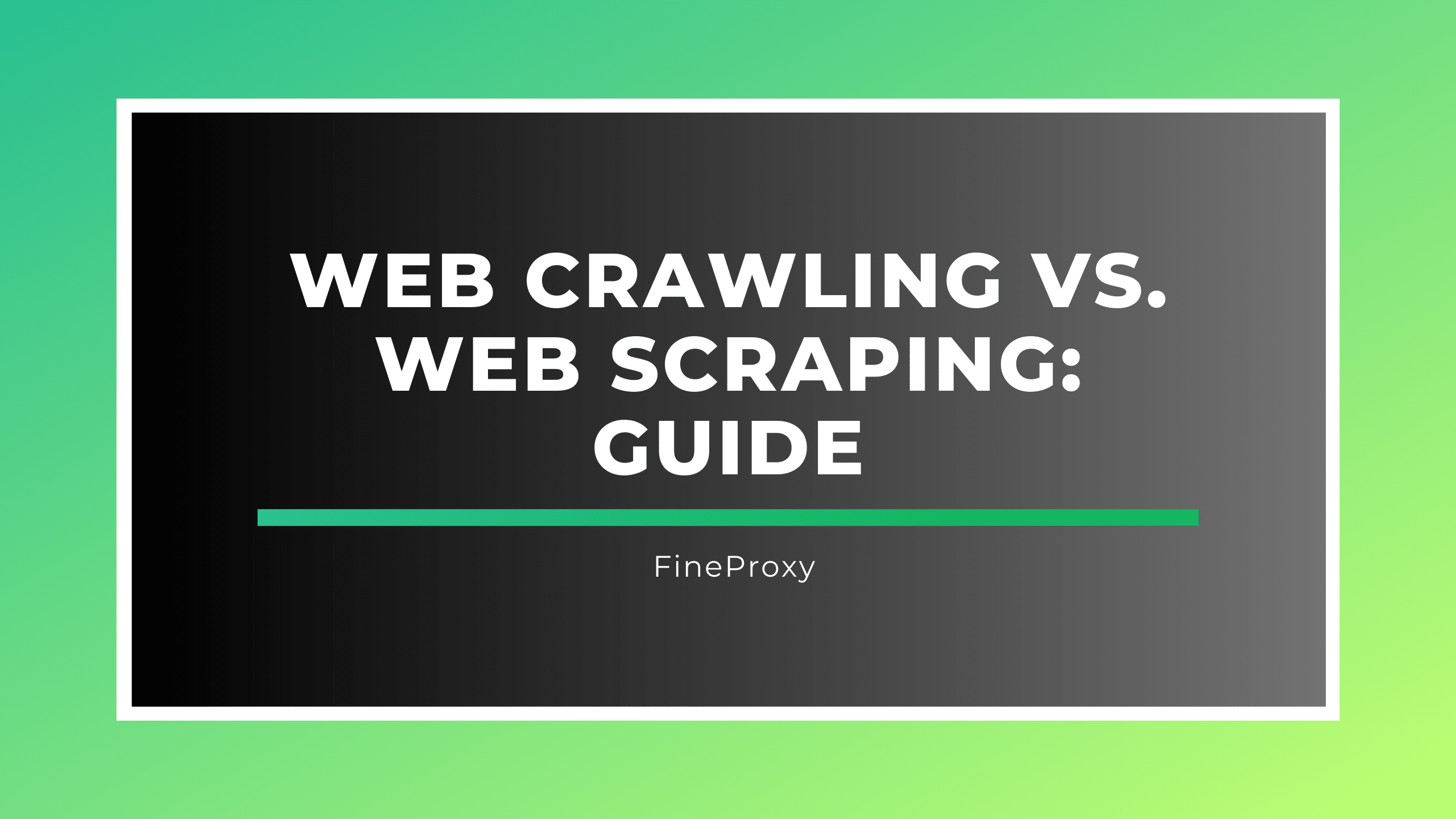
- What is the fundamental difference between Web Crawling and Web Scraping?
- How do Web Crawlers work, and what are their common uses?
- What are the key techniques and tools used in Web Scraping?
- What are the ethical and legal considerations involved in Web Scraping?
- How are advancements in AI and Machine Learning impacting Web Crawling and Web Scraping?

Introduction to Web Crawling and Web Scraping
In our increasingly digital world, the significance of web data cannot be overstated. Web Crawling and Web Scraping emerge as key players in the realm of online data extraction, handling vast amounts of information with ease. Although these terms are often used interchangeably, they differ fundamentally in their objectives and methodologies. This detailed exploration will shed light on these technologies, demarcating their unique roles and significance in the digital landscape, including the benefits of web scraping.
Understanding the Basics
Web Crawling is a foundational process for search engines, enabling them to systematically browse the web and index its content. This is achieved through automated programs known as crawlers or spiders, part of various web crawling services. These bots navigate the internet, visit web pages, follow the links on these pages, and bring data back to the search engine’s servers for indexing. This process is crucial for search engines to deliver relevant search results and understand the ever-growing web structure.
Conversely, Web Scraping is a more focused technique aimed at extracting specific pieces of data from websites. Unlike the broad approach of crawlers, scrapers are designed to target particular web pages and extract precise information like product prices, weather data, or social media posts. This data, once extracted, can be used in various contexts, from market research to competitive intelligence, making web scraping a valuable tool for businesses and researchers alike.
Key Differences at a Glance
Distinguishing between web crawling and scraping is crucial for understanding their respective roles in data management. Web crawling is about navigation and indexing, akin to creating a map of the internet’s vast territory. In contrast, web scraping is akin to a targeted expedition to retrieve specific data points from certain locations on this map. Additionally, web scraping often involves data parsing, converting the raw data extracted from web pages into a structured and usable format, a step beyond the scope of traditional web crawling.
Deep Dive into Web Crawling
To truly grasp the digital ecosystem, an understanding of web crawlers is essential. These digital explorers, quietly operating behind the scenes, are fundamental to how we experience and interact with the vast expanse of the internet.
Definition and Core Concepts of Web Crawling
Web crawling, at its core, is an automated process where a program, known as a web crawler, systematically browses the World Wide Web. This is primarily done to create a replica of all visited pages for subsequent processing by a search engine, which indexes these pages to facilitate quick and relevant searches. Beyond indexing, crawlers are also employed for various purposes such as hyperlink validation and HTML code checking. They play a pivotal role in gathering content for archival purposes and in numerous other data-oriented applications, supported by the best web crawling tools available.
How Web Crawlers Work
The journey of a web crawler begins with a list of web addresses, termed ‘seeds’. As the crawler visits these seeds, it identifies hyperlinks on the pages and adds them to a queue known as the crawl frontier. This process continues recursively, governed by specific policies like crawl frequency, page priority, and types of content to fetch or ignore. These policies help crawlers navigate the complex web environment efficiently, ensuring relevant and up-to-date information is captured without overwhelming the host servers or violating web standards.
Common Uses of Web Crawlers
Web crawlers serve a plethora of purposes. The most prominent use is in powering search engine operations. Major search engines like Google and Bing rely heavily on these crawlers to build and refresh their extensive indexes of the web, making online information accessible and searchable. Beyond search engines, web crawlers are instrumental in web archiving, data mining, and analytics. Businesses use these tools for a variety of reasons, including monitoring competitors’ web presence, conducting market research, and extracting public sentiment from social media platforms.
Challenges and Limitations of Web Crawling
Navigating the web’s enormity is not without challenges. Web crawlers must deal with the sheer size and constantly changing nature of online content. They are bound to respect the guidelines set by websites in their robots.txt files, which may restrict their access to certain areas. Crawlers also need to effectively handle duplicate content, broken links, and the potential for infinite loops. The complexity of managing dynamic content created by JavaScript and balancing the load on web servers further adds to the list of technical hurdles. These challenges require continuous refinement of crawler algorithms to ensure efficient and ethical data collection. The emergence of open source web scraping tools, such as open source screen scrapers and open source scrapers, has made it more accessible for individuals and organizations to engage in web scraping, complementing traditional web crawling techniques.
Exploring Web Scraping
The digital landscape offers a wealth of data, and web scraping is a key method for tapping into this reservoir. Differing from web crawling, which broadly indexes web content, web scraping is a focused approach aimed at harvesting specific data from web pages. This technique has become indispensable in a variety of fields, offering precise and efficient data extraction through tools like web scraping tools open source.
Defining Web Scraping and Its Mechanisms
Web Scraping is a nuanced process where specialized software is used to extract information from websites. This technique involves several steps: initially, the scraper makes a request to the target website; then, it downloads the web page content. The critical phase is the parsing of HTML or XML content of the page to identify and extract the required information. The complexity of this task can vary significantly, from simple text extraction to dealing with intricate JavaScript-rendered content. The essence of web scraping lies in its ability to transform unstructured web data into a structured format that can be used for various purposes, highlighting the scraping vs crawling distinction.
Techniques and Tools in Web Scraping
The arena of web scraping is rich with diverse techniques and tools. These range from basic HTML parsing, using simple yet effective libraries like Python’s Beautiful Soup, to more elaborate methods capable of handling JavaScript and AJAX-heavy sites. Tools like Scrapy offer a robust framework for building scalable scrapers. For those less inclined to code, GUI-based tools provide a user-friendly alternative, automating many of the scraping tasks. The rise of open source web scraping technologies, including web scraping tools open source, has democratized access to web scraping capabilities. These open source tools offer flexibility and customization, allowing users to tailor their scraping experience to their specific needs.
Practical Applications of Web Scraping
The applications of web scraping are as varied as they are impactful. In the business realm, it’s a potent tool for market research, competitive analysis, and price monitoring, providing businesses with crucial insights into market trends and competitor strategies. In academia, researchers use web scraping for gathering vast amounts of data for studies and analysis. Journalists utilize scraping techniques to collect information for stories, while product development teams leverage it to gather customer feedback and market trends. One of the most significant applications is in the field of machine learning and data science, where large datasets, often obtained through scraping, are essential for training and refining algorithms.
Ethical and Legal Considerations
The power of web scraping brings with it significant ethical and legal responsibilities. Ethically, it’s crucial to respect individual privacy and the integrity of the websites being scraped. Legally, scraping poses several challenges. It can raise issues related to copyright infringement, breach of contract (in case of violating website terms of service), and data protection laws like GDPR. It’s essential for practitioners to navigate this landscape carefully, ensuring compliance with legal requirements and ethical norms. Utilizing open source web scraping solutions often helps in adhering to these norms, as many are designed with ethical considerations in mind.
Comparing and Contrasting Web Crawling and Web Scraping

Web Crawling and Web Scraping, though often mentioned together, serve distinct purposes in the digital ecosystem. Understanding their differences is key to leveraging each technique effectively, especially in the context of web crawling vs web scraping and crawling vs scraping.
Technical Comparison: Scope, Depth, and Methods
Web Crawling, often conducted by tools like open source search engine crawler and open source website crawler, is characterized by its broad scope, aiming to index a wide array of content across the internet. Web Scraping, in contrast, has a narrow focus, targeting specific datasets on particular web pages. The depth of web crawling is typically shallower, as it involves scanning numerous sites without delving deeply into their content. Scraping, however, often requires a deep dive into selected sites to extract detailed information. The methodologies differ significantly as well; web crawling is about navigation and indexing of web content, while scraping involves sophisticated parsing techniques to extract and transform data, as seen in the debate of crawl vs scrape.
Use Case Scenarios: When to Use Each
Selecting between web crawling and scraping depends on the specific data needs. Web crawling is ideal for tasks like creating a comprehensive index of web content for a search engine, or for broad data collection for trend analysis. This process can be conducted using methods on how to web crawl a site, employing the best web crawlers and internet crawler open source tools. Web scraping, on the other hand, is the method of choice for extracting specific information from websites, such as product details from e-commerce sites or real-time data for market analysis. The decision hinges on the nature of the data required and the scale of the operation.
Overcoming Challenges: Best Practices and Solutions
Both techniques face unique challenges, from technical hurdles to ethical and legal issues. For web crawling, challenges include managing the vast amount of data and adhering to the limitations set by website administrators. In web scraping, the challenges range from dealing with complex website structures to ensuring legal compliance. Best practices involve respecting a website’s robots.txt for web crawling, ensuring ethical data extraction in web scraping, and using efficient algorithms that minimize the load on web servers. Keeping abreast of legal developments and technological advancements is also crucial for practitioners in this field.
Advancements and Trends in Web Crawling and Scraping
The dynamic fields of web crawling and scraping, often discussed in terms like web scraping vs crawling and web crawling vs scraping, are evolving rapidly in the modern data-driven era. These advancements are shaping how we understand and utilize the processes of crawling data and scraping information from the web.
The Role of AI and Machine Learning
The integration of Artificial Intelligence (AI) and Machine Learning (ML) is revolutionizing the capabilities of web crawlers and scrapers, or, as some might say, the crawler vs scraper dynamics. AI is enhancing web crawlers, empowering them with advanced algorithms that improve decision-making in web crawling meaning and optimize the web crawling process. In scraping, ML’s role is pivotal in understanding the context of the data, moving beyond what’s data scraping into more sophisticated realms of data interpretation.
Future Prospects and Emerging Technologies
Emerging technologies are expected to expand the capabilities of web crawling and scraping, terms often interchangeably used with web crawler vs web scraper and web scraping vs web crawling. We’re seeing developments in predictive analytics and advanced pattern recognition which will not only make these tools more efficient but also autonomous. The open source web crawler community is particularly active in evolving the web crawler algorithm, enhancing the ability to crawl data from website sources more effectively.
Implementing Web Crawling and Scraping in Business
Web crawling and scraping, or data crawling and webcrawling as they are known, are increasingly being integrated into business operations, offering strategic advantages for data-driven decision-making.
Strategic Advantages for Businesses
Businesses are leveraging the strategic advantages of web crawling and scraping (or web crawler vs scraping) to gain a competitive edge. These technologies provide crucial insights into market trends and consumer behaviors by enabling businesses to efficiently collect and analyze data. This data-driven approach, encompassing everything from website crawling tools to define scrapers, transforms how businesses strategize and make decisions.
Integrating Crawling and Scraping into Business Processes
The integration of web crawling and scraping into business processes is transformative. It involves the use of automated tools to gather data (how to crawl data from a website), and scraping tools to extract specific data points for analysis. This integration, which often involves understanding web crawling meaning, streamlines data collection and analysis, allowing businesses to respond rapidly to market changes and customer needs with accurate data crawling insights.
Case Studies: Successful Applications in Various Industries
Web crawling and scraping have been successfully implemented across various industries, showcasing their versatility. Retail companies use these technologies for price monitoring and inventory management, financial institutions for real-time market data analysis, and travel agencies for fare aggregation. Each of these applications demonstrates how effectively crawling sites and scraping web data can provide businesses with a competitive advantage.
Conclusion
Summarizing Key Takeaways
In conclusion, web crawling and scraping (or crawling web and data scraping) have become vital in the field of digital data collection and analysis. The advancements in these areas, particularly in AI and ML, have significantly enhanced their capabilities. The distinction between web crawler vs web scraper and the broader understanding of what is web indexing have become crucial in leveraging these technologies effectively.
Future Outlook and Potential Developments
The future of web crawling and scraping is promising, with continuous advancements expected in technologies like AI, ML, and cloud computing. These developments will enhance the efficiency and intelligence of these tools, enabling businesses to harness the power of web data in unprecedented ways. As the fields of web crawling and scraping evolve, they will open new avenues for data analysis and business intelligence, further solidifying their role in the data-driven business landscape.






Comments (0)
There are no comments here yet, you can be the first!